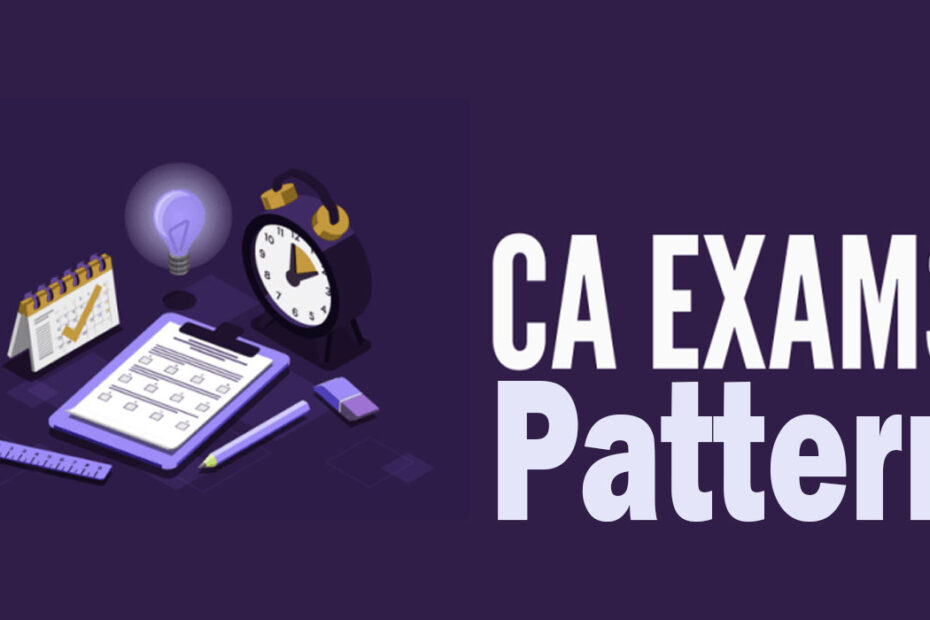Becoming a Chartered Accountant (CA) is an illustrious and fulfilling career path. However, achieving this esteemed title demands unwavering dedication and effort. The key to triumphing in this journey lies in comprehending the intricacies of the CA exam pattern, a pivotal component of the entire program.
Decoding the CA Exam Pattern for 2023
The CA exam pattern serves as the evaluation framework designed by the Institute of Chartered Accountants of India (ICAI) to assess the proficiency of candidates enrolled in the CA program. This comprehensive pattern entails a fusion of theoretical and practical evaluations, which encompass written assessments, practical training modules, and on-the-job experiences. Navigating through this assessment landscape is imperative for progression within the CA program.
Levels of the CA Program: Unveiling the Progression
The CA program in India encompasses three progressive tiers: CA Foundation, CA Intermediate, and CA Final. The initiation phase is marked by the CA Foundation course, consisting of four distinct papers. Following this is the CA Intermediate level, which signifies a deeper engagement, culminating in the CA Final – the ultimate pinnacle of the CA journey.
Read Also: GRE Exam Fees 2023: GRE Exam Costs in India
Architecting the CA Exam Pattern for 2023
CA Foundation Exam Pattern:
The CA Foundation examination comprises four papers, each holding a weightage of 100 marks. The initial two papers entail subjective responses, whereas the latter two adopt an objective approach. Notably, negative marking is applicable to the objective papers, wherein an incorrect response translates to a deduction of 1/4 of a mark.
Paper Subject Paper 1: Principles and Practice of Accounting Paper 2: Business Laws, Business Correspondence and Recording Paper 3: Business Mathematics, Logical Reasoning and Statistics Paper 4: Business Economics and Business and Commercial Knowledge
Exam Frequency and Other Pertinent Details
The CA Foundation examination is scheduled biannually, transpiring in June and December. Prospective candidates enrolled in the Foundation course must undergo an application process to participate in the examination. Each paper within the CA Foundation exam comprises a compilation of 100 questions.
Read Also: CAT Exam 2023 Registration Date
CA Intermediate Exam Pattern:
The CA Intermediate exam pattern for May 2023 entails eight papers, thoughtfully divided into two distinct groups. These papers encompass a blend of objective and subjective questions, with candidates allotted 3 hours for each paper. The significance of each paper is underscored by its 100 marks weightage, culminating in an aggregate of 800 marks for the entire CA Intermediate examination.
Group I
Paper 1: Accounting Paper 2: Corporate and Other Laws Paper 3: Cost and Management Accounting Paper 4: Taxation
Group II
Paper 5: Advanced Accounting Paper 6: Auditing and Assurance Paper 7: Enterprise Information Systems & Strategic Management Paper 8: Financial Management and Economics for Finance
Passing Criteria for CA Intermediate
Candidates must surpass the minimum threshold to achieve the coveted CA Intermediate Result 2023. This entails securing an overall score of 40% in individual papers and 50% for the group score. The benchmark for success in each individual paper is a score of 40, while the collective group score reaches 200.
CA Final Exam Pattern:
The CA Final Exam unfurls across two groups, encompassing a total of eight papers, each bearing a significance of 100 marks. The pathway to triumph necessitates attaining a minimum score of 40 marks in each paper, ultimately amassing a cumulative 400 marks. It is important to note that negative marking is not in practice. The examination itself juxtaposes descriptive questions with objective queries, encapsulating the following subjects:
Group 1 (the new syllabus):
- Financial Reporting (100 Marks)
- Strategic Financial Management (100 Marks)
- Advanced Auditing and Professional Ethics (100 Marks)
- Corporate and Economic Laws Part I: Corporate Laws (70 marks) Part II: Economic Laws (30 marks).
Group 2:
- Strategic Cost Management and Performance Evaluation (100 Marks)
The CA Final Exam is designed to span a duration of 3 hours. To qualify for this culmination of the journey, aspiring candidates must complete their registration by the stipulated date of July 1, 2023, for the ensuing November/December 2023 examinations.
FAQs – Navigating the CA Exam Landscape
Q1: What Comprises the CA Exam Stages?
The CA exams are stratified into three tiers: CA Foundation, CA Intermediate, and CA Final. Each level is overseen by the Institute of Chartered Accountants of India (ICAI), with successful completion unlocking the title of a Chartered Accountant.
Q2: What Constitutes Passing Marks for CA Exams?
Achieving success in CA exams necessitates securing a minimum of 40% in each paper and an aggregate of 50% across all papers within a single group, whether at the Intermediate (IPCC) or Final level.
Q3: Nature of CA Exam Format?
The Foundation Course is characterized by a Computer-Based Exam (CBE) accentuated by Multiple-Choice Questions (MCQs). The Intermediate (IPCC) and Final exams, however, amalgamate MCQs with descriptive-type questions, primarily requiring written responses.
Q4: How Many Papers Per Exam Stage?
The CA foundation exam encompasses 4 papers, the CA intermediate/IPCC examination encompasses 2 groups with 4 papers each, and the CA final exam entails 2 groups with 4 papers within each group.
Q5: Shedding Light on the CA Exam Pattern?
The Foundation Course manifests as a Computer-Based Exam (CBE) housing multiple-choice questions (MCQs). In contrast, the Intermediate (IPCC) and Final exams incorporate a blend of MCQs and descriptive-type questions, largely necessitating written answers.
Q6: Unveiling the Novel CA CPT Exam Pattern
The 2023 CA CPT examination unfolds in two sessions, encompassing two subjects each. A total of 2 hours is allocated for the examination, with each session commanding 100 marks. This examination adheres to an offline format, with the forenoon and afternoon sessions distinguishing the examination schedule.
